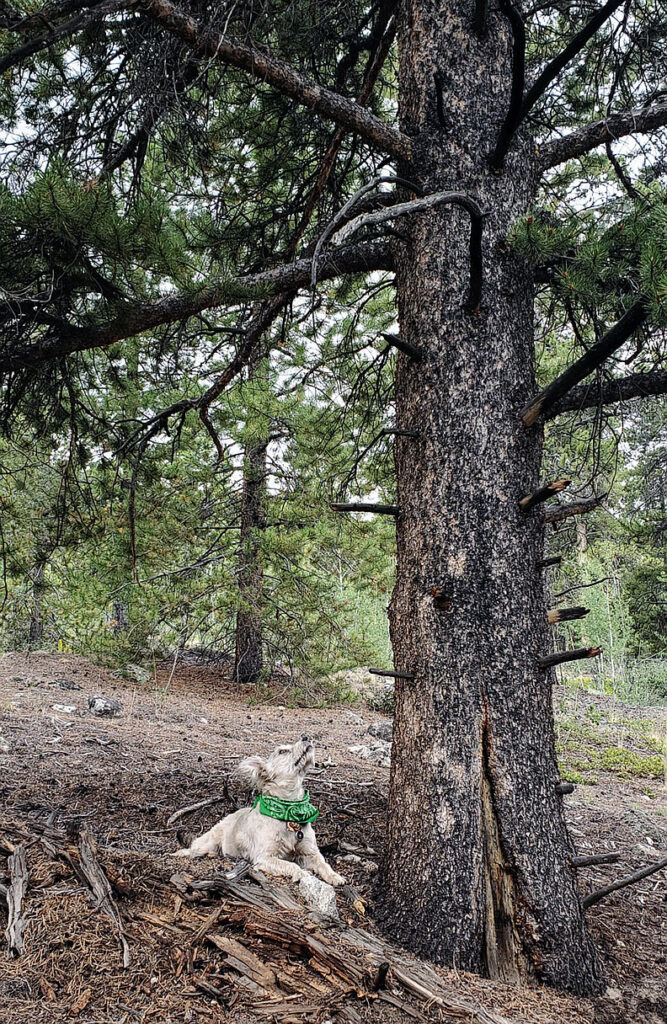By Solana Kline — (A lifelong dog-rescue advocate and avid back-country motorcycle adventure rider)
If your family looks like mine, it is 2/3 furry canine and 1/3 relatively hairless human. We are a dog-pack. I joke that we are feral and too wild for the city, spending most of our time out-side, away from the confines of human social rules.

They know what each of the 5 or so different whistles I belt out mean. If I giggle behind them on the trail, their tails waggle faster and faster the more I laugh, responding in their own physical form of laughter. I read their body language on the trail and from this can tell if there is a person, a dog, or another animal ahead based on how they hold their head, ears, tails, bod-ies. I know the difference between their happy-rough-play growls and their there’s-a-bear-up-there snarls.
We communicate with one another with relative ease, even though they don’t speak to me in human English, and I don’t speak to them in rear end sniffs. How the heck do we do this?
How does my terrier, Betty, know to come lick my face and snuggle if I am crying or hurt? How does my wiggly pitbull/boxer, Mickey, know to walk to me, boop my leg with his nose, then walk to the empty water bowl and boop it with his nose, then walk over to the water jug and boop it with his nose when he is thirsty? It is way more than me attributing human qualities to my dog’s behavior, it boils down to co-evolutions between our species for thousands of years!

Dog-human communication is complex and incredible! If you spend as much time with your dog pack as I do, the ways that dogs communicate with one another and with us humanoids is absolutely amazing. This might come as no surprise to those of you that know just how long humans and dogs have been co-evolving in their day-to-day livelihoods. We (and they!) have been lucky enough to be working together symbiotically as species for ruff-ly 10,000 years! Remains were even found of humans interred with dogs 14,000 years ago.
Dogs and humans figured out pretty quickly that they could really scratch each other’s backs for survival if they worked together. The common theory is that about 10,000 years ago, humans in some areas around the world began to become more sedentary due to the transition from hunting and gathering to dependence on year-round agriculture.

While it seems humans and wolves did interact off and on before this, the relatively more permanent agricultural communities meant more refuse and longer exposure to specific animals inhabiting the same territories. The braver wolves would scavenge from human food scrap piles and would even be rewarded with food for their work guarding the humans and their stock from other animals. Eventually, the lives of dogs and humans became so inter-twined that it goes beyond transactional symbiosis, dog-human relationships in many cultures are rooted in tight knit social bonds, with humans even including dogs in their cultural myths!
Like any good relationship, communication is key. Recognizing hints of communication of others is essential for cooperation within species and across them. This level of cross-species communication is rare in the animal kingdoms, and if we pay attention, our furry friends are in constant communication with us, and us with them! Humans and dogs intuitively and actively communicate with each other through a lot of different channels such as eye contact and other senses, body language/positioning, vocal tone, and pheromones/chemical expression. Dogs are even able to translate what they are seeing and doing into communication types that humans can understand.

Working dogs and human scientists are now experimenting with various types of wearable technologies such as vests that contain sensors that the dogs can activate to communicate messages to hu-mans. These sensors activate actions and messages, including a service dog’s vest where the pup can bite a sensor that calls 911 for their owner, or search and rescue dogs that can choose various sensors on their vests to send messages to their human searchers such as “I found the person and they are alive”, “I found the person and they are deceased”, “I found a trail/clothing”, etc. It is clear that dogs are adept at dog-human communication and now new technologies to translate their experiences to us!
In our everyday lives, dogs read our facial and body cues, listen to our voices, and have a working database of our language and commands. As anthropocentric (human-centered) humans, we may be less adept at reading their communication strategies, but with a little more attention, we can reciprocate attentive communication with our pups to improve our relationships and interactions! Our pups will look to us as their pack leader for communication leads. Eye contact has become a big one here! Dogs are actually naturally much more rooted in smells to “see” the world, they even have a whole chamber within their sinuses to hold smells in place so that they can continuously smell them while circular breathing through those little tear drops in their nostrils. But eye contact is one of the main ways that humans and dogs have learned to connect with one another.
Have you ever noticed your dog’s eyes and surrounding features telling you exactly what they want or need? How their eyes open wider than you ever thought possible if you feed them the most delicious treat? Or how they actually look worried when they are sick or hurt? These are very real communication strategies, just as they are for humans.
Dogs communicate with us through their tail positioning and movement, their facial expressions and head carry, body positioning, vocalizations, ear positioning, and their senses. Next time you are out with your 4 leggers, see if you can pick out their communication clues. You might notice affectionate and social bonding licking, nervous or happy smiles, a worried tail wag versus a happy one.
How many different vocal “words” does your dog have and what do they mean? What does your dog’s whole body do when they want to play? How do they talk and move when they play, and how does this look different than when they are afraid/avoidant, or when they are aggressive or frustrated?
Our pups put a lot of time and attention into noticing our behaviors to make our social interactions more smooth and healthy, what if we paid them the same respect and attention? There would be a lot less confusion and uncomfortable or dangerous interactions in our cross-species interactions! Until next time, happy tails!
Footnotes:
- From the article, Why Dogs and Humans Love Each other More Than Anyone Else, Time Magazine, 7/20/2018, https://time.com/5342964/human-bond-dog-thoughts/#:~:text=But%20elsewhere%20in%20the%20genome,to%20similar%20sweetness%20in%20humans.
- From the article, Impact of the Dog-Human Bond on Canine Social Evaluation: Attachment Predicts Preference toward Prosocial Actors, Animals, https://doi.org/10.3390/ani13152480 AND Canine Perspective Taking, Animal Cognition (2023)26:275-298.
- From the article, Dog Speak: How our Dogs Communicate with us and how we can Talk Back.
- https://www.howimetmydog.com/index.php/blog/dog-speak-how-our-dogs-communicate-with-us-and-how-we-can-talk-back
- Check this out online! https://gvu.gatech.edu/research/projects/fido-facilitating-interactions-dogs-occupations#:~:text=The%20FIDO%20Sensors%20team%20is,path%20that%20must%20be%20avoided.
- From the article, FIDO- Facilitating interactions for dogs with occupations: wearable communication interfaces for working dogs. Pers Ubiquit Comput (2015) 19:155-173.
- Check out some of these dog behavior cues: https://harstinedogbehaviorcenter.wordpress.com/2015/05/18/understanding-a-dogs-body-language/
- From book, An Immense World, Ed Yong, 2022, Chicago Press
- From article, Uncovering the origins of dog-human eye contact: dingoes establish eye contact more than wolves but less than dogs, Animal Behavior, 133(2017)123-129.}


